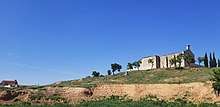Nava de Roa
Nava de Roa is a municipality and town located in the municipality of Ribera del Duero, province of Burgos, Castile and León, Spain. It is located 92 km from Burgos, 26 km from Aranda de Duero, and 70 km from Valladolis. According to the 2004 census (INE), the municipality has a population of 246 inhabitants.
Nava de Roa | |
|---|---|
| Country | Spain |
| Autonomous community | |
| Province | |
| Comarca | Ribera del Duero |
| Area | |
| • Total | 22 km2 (8 sq mi) |
| Elevation | 794 m (2,605 ft) |
| Population (2018)[1] | |
| • Total | 224 |
| • Density | 10/km2 (26/sq mi) |
| Time zone | UTC+1 (CET) |
| • Summer (DST) | UTC+2 (CEST) |
| Postal code | 09318 |
| Website | http://www.navaderoa.es/ |
The name "Nava" has pre-Roman origins and means"flat land surrounded by hills." The village is mainly known for the quality of its Designation of Origin Ribera del Duero wines.
Nava de Roa has an important historical heritage in religious buildings. The parish church of San Antolín Mártir is from the XVII century and was developed in the XVIII. It has a Baroque façade and neoclassic tower. Inside, there is an altarpiece which was built by Pedro Cicarte, decorated by Pedro Pérez and there is also a baptismal font from the XVI century. There is also a Gothic Christ of large dimensions, probably from the XIV century.
The chapel of Santa Ana, located on the Monte Calvario, is of Baroque style but it has not been conserved and it currently remains in ruins. The municipal cemetery can be found on its premises and on the hillsides, the characteristic wine cellars and remains of old wine-presses can be seen.

Lastly, it is possible to see models of popular architecture with wooden framework in its walls, which survived the fire of Nava de Roa in the XIX century.
Wheat, barley and beetroot are grown in the village. More importantly grapes are also grown in the village, of which Designation of Origin wines are made. There are two wineries dedicated to its production and use: Montebellón Winery and Vineyards and Señorío de Nava Winery.
History of Nava de Roa[2]
The village emerged from the medieval repopulation during the X and XI centuries; its greatest period of glory was between the XVI and the XVIII centuries. It benefited from being a hub of communication and a cross roads (Valladolid-Soria- and Segovia-Zaragoza). In 1591, the community had 1,569 residents.
At the fall of the old regime it remained constituted as the Town Council of the judicial district of Roa with 186 dwellings and 605 residents.
The XIX century marked the decline of Nava de Roa with two incidents: the total destruction (1836) in the period of the First Carlist War by General Miguel Gómez Damas and the Phylloxera Plague which eliminated the vineyards of the area, and, therefore, its economy. The decrease in population until this very day has been continuous.
In the past, Juan Martín El Empecinado (The Stubborn one) the famous guerilla who fought against the Napoleonic troops, was imprisoned in Nava de Roa after his capture in Olmos de Peñafiel (1823). He was later handed over to the Mayor of Roa de Duero, Gregorio González. In the end he was executed in 1824.
The feast day of San Antolín Mártir is celebrated on September 2 and is of major local importance. The feast day of San Gregorio Nacianceno is locally celebrated, on May 9.
References
- Municipal Register of Spain 2018. National Statistics Institute.
- https://www.rutadelvinoriberadelduero.es/es/poblacion-ribera-del-duero/nava-roa